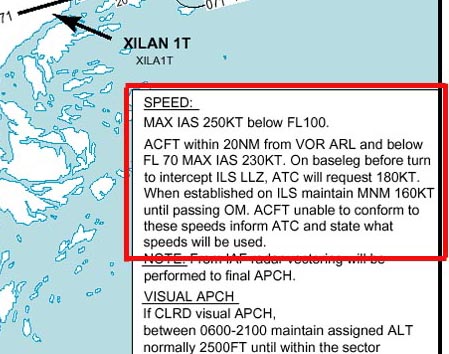Descent¶
It's important to plan your descent in advance, otherwise you will have the
risk of being both too high and too fast when approaching your destination
A good rule is to use the formula "3 to 1" for descent planning.
This formula means that it will take 3 Nm to descent 1000 feet. So for example
if you are cruising at FL310 this would mean that you start your descent 31 x 3
Nm = 93 Nm from your destination, based on a normal jet aircraft, idle thrust,
speed M 0.74 - M 0.78 and vertical speed 1800 - 2200 feet / min.
Adjustments for head and tailwind:
- Tailwind: Add 2 Nm for each 10 kts tailwind. 40 kts tailwind: 40 / 10 * 2 = 8 Nm
- Headwind: Retract 2 Nm for each 10 kts headwind. 20 kts headwind: 20 / 10 * 2 = 4 Nm
The objective is to determine the most economical TOD (top of descent), with the general intention to use thrust only when established on Glide slope.
Descent procedure
Before initiating descent go through the descent checklist.Start your descent by setting your new cleared altitude given by ATC, and use VERT SPD mode initially with 500 - 1000 feet / minute. This will give a smooth transition both for PAX, crew and the engines will have a smoother spool down.
After a while continue your descent with idle thrust. We continue on idle descent until FL120 (if we get cleared all the way) and go back into VERT SPD mode, set it to 1200 - 1000 feet / minute to reduce speed to 250 kts.
It is wise to go over to VERT SPD mode when you have started the approach. This modes gives the pilot control of the descend rate and it is easy to calculate crossing points
Bigger airports have speed restriction that below FL100 maximum speed is 250 kts, sometimes the speed restrictions continue as you descent
(See below example from ESSA STAR 26)

In London TMA they have "SLP" Speed Limiting Points and then the restriction is at fix point instead of altitude
During low-peak hours there is always a possibility to request high speed approach. If granted by ATC you can continue to descent with your descent speed until you have to reduce for final approach or ATC requests. When you are cleared down to a altitude below "TL, transition level" reset your QNH from std, 1013 mb, to the local setting.
- FL100 30 Nm before touchdown
- Speed 250 kts (if no restrictions exist) until 17 Nm before T/D
- Speed 230 kts (if no restrictions exist) until 14 Nm before T/D
- At 14 Nm reduce speed to 210 kts and select flaps 5
- Once less than 11 Nm we reduce to 170 Nm and select flaps 10
- Now we are about to establish on glide slope and 1.5 dot above vertical center we select gear down
- At 1 dot above center on GS we select flaps 15 and speed 160 kts (which should be flown until OM (outer marker)
- Passing OM set spd to Vref + 5 kts and extract flaps accordingly to the speeds
- Vref+5 until flare. At 50 feet initiate flare by gently rotate the plane and start to reduce thrust. Reduce thrust to be idle when at T/D